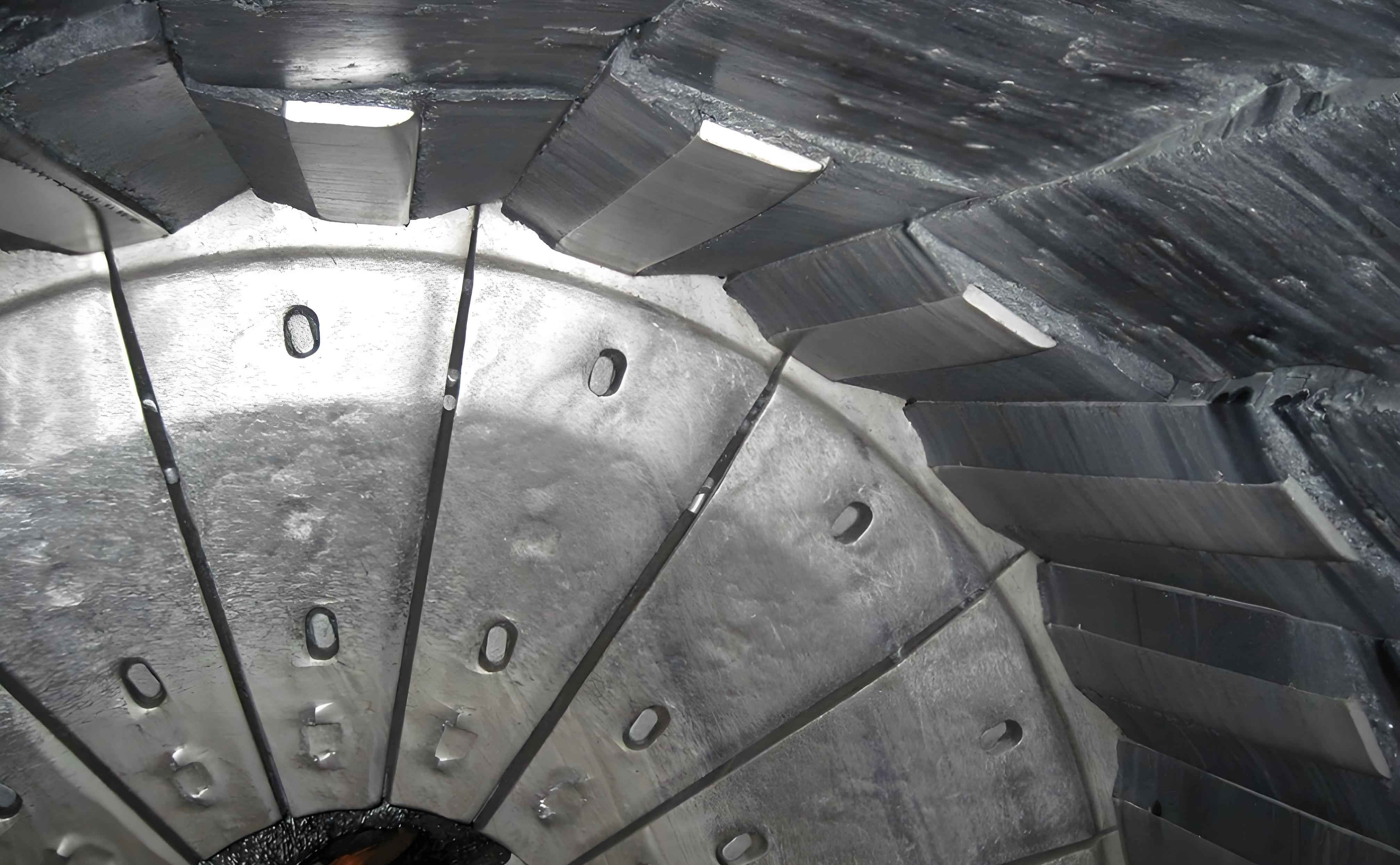1. Introduction
Gyratory crushers are pivotal equipment in mining operations, designed to crush large ore particles into manageable sizes. At the heart of these crushers lies the dynamic cone assembly, which performs a gyratory motion to generate compressive forces for ore fragmentation. Protecting the cone’s main shaft are lining plates—replaceable wear-resistant components that endure significant mechanical stress. However, replacing these lining plates poses challenges due to the complex nut-fastening system and the risk of damaging critical components during disassembly.
This article focuses on the nut removal process for the dynamic cone lining plate in the Kawasaki KG15522 gyratory crusher deployed at Namibia’s Lake Mountain Uranium Mine. Traditional methods, such as direct nut loosening or radial cutting, often result in costly part replacements and operational delays. A novel upper lining plate cutting process (Process ④) is proposed to mitigate these issues, emphasizing reduced repair difficulty, cost savings, and enhanced reliability.

2. Existing Nut Removal Processes: Comparative Analysis
Four conventional methods have been historically employed for lining plate nut removal. Their advantages and limitations are summarized below:
Table 1: Comparison of Traditional Nut Removal Processes
| Process | Description | Advantages | Limitations |
|---|---|---|---|
| ① Direct Loosening | Use hydraulic hammers to strike welded arms on the nut. | Simple setup. | High risk of thread damage; requires precise force control. |
| ② Radial Nut Cutting | Cut the nut radially using oxy-acetylene torches. | Fast execution. | Destroys nut and torch ring; damages thread sleeves. |
| ③ Torch Ring Cutting | Rotational cutting of the torch ring below the nut. | Preserves the nut. | Risks shaft neck damage; destroys torch ring. |
| ④ Upper Lining Plate Cutting | Circular cutting of the upper lining plate at 150 mm below the top surface. | Minimizes part damage; reusable components. | Requires skilled operation. |
Key Observations:
- Processes ①–③ frequently damage high-cost components like the lining plate, nut, and torch ring.
- Thread sleeve repairs are time-consuming and labor-intensive.
- Process ④ strategically avoids critical areas (e.g., shaft neck, thread sleeves), making it superior in cost-effectiveness and safety.
3. Proposed Process: Cutting the Upper Lining Plate
3.1 Process Principle
The upper lining plate is structurally tapered, with its thickness decreasing significantly below the top surface. By cutting the plate at a depth of 150 mm, the epoxy resin layer beneath is exposed. This resin, being compressible, releases the preload on the nut, allowing easy removal without damaging adjacent components.
3.2 Operational Steps
- Marking the Cutting Zone: Identify the cutting line 150 mm below the lining plate’s top surface.
- Circular Cutting: Use a rotational cutting torch to penetrate the lining plate until epoxy resin emits black smoke (visual indicator).
- Nut Removal: Loosen the nut effortlessly due to released tension.
- Component Reuse: Clean and reuse the nut, torch ring, and thread sleeve.
3.3 Mechanical Analysis
The stress distribution during cutting can be modeled using the following equation:σ=FA+M⋅yIσ=AF+IM⋅y
Where:
- σσ: Stress at the cutting zone
- FF: Axial force on the lining plate
- AA: Cross-sectional area
- MM: Bending moment
- yy: Distance from the neutral axis
- II: Moment of inertia
Figure 1: Stress Distribution in the Upper Lining Plate
(Hypothetical diagram showing reduced stress concentration away from the shaft neck.)
4. Case Study: Application at Lake Mountain Uranium Mine
4.1 Cost Savings
Implementing Process ④ yielded significant financial benefits:
Table 2: Cost Comparison Before and After Process ④
| Component | Traditional Process Cost (NAD) | Process ④ Cost (NAD) | Savings (NAD) |
|---|---|---|---|
| Large Nut | 399,643 (new purchase) | 0 (reused) | 399,643 |
| Torch Ring | 200,000 (new purchase) | 0 (reused) | 200,000 |
| Labor | 120,000 | 40,000 | 80,000 |
| Total | 719,643 | 40,000 | 679,643 |
4.2 Operational Efficiency
- Time Reduction: Nut removal time decreased from 4 days (Process ②) to 8 hours.
- Safety Improvement: Zero incidents of shaft neck damage or thread sleeve failure.
Figure 2: Field Application of Upper Lining Plate Cutting
(Hypothetical image showing precise torch alignment and minimal thermal spread.)
5. Conclusion
The upper lining plate cutting process revolutionizes lining plate maintenance in gyratory crushers by:
- Preserving Critical Components: Nuts, torch rings, and thread sleeves remain intact.
- Lowering Costs: Annual savings exceed 1.2 million NAD at Lake Mountain Mine.
- Enhancing Safety: Eliminates risks associated with shaft neck damage.
This method sets a benchmark for similar mining equipment, demonstrating that strategic process redesign can achieve both economic and operational excellence.
